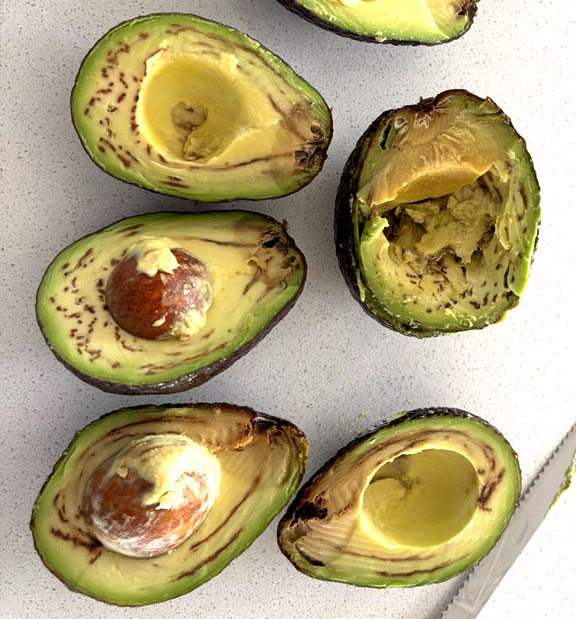When receiving avocados it is always best practices to cut a few specimens in each sample. Make sure to cut the ripest fruit first to determine if any internal defects are present.

You may come across this defect, a streaky brown discoloration affecting the flesh of the avocado. This is called vascular browning. If you simply called the defect internal discoloration, accompanied with images of the defect to your vendor this would suffice.
If you look a little closer at the image above, you can also see the initial stages of stem end decay developing. Decay would take precedent over the internal discoloration, scored as decay against the 1% tolerance. If no decay was present, then these avocados would have been scored as serious damage by internal discoloration, against the 10% tolerance for total defects.
Google provided some interesting background information regarding this defect:
“Vascular browning in avocados refers to a defect where the avocado’s vascular tissue (the “plumbing” that transports nutrients) turns dark brown or black, often starting at the stem end and extending towards the seed. It’s a common issue, and while it may make the avocado look unappetizing, it’s generally safe to eat. Causes:
- Cold Temperatures: Chilling injury, especially in the refrigerator, is the most common culprit. Cold temperatures weaken the cells, leading to tissue death and browning.
- Overripeness: If an avocado is left too long at room temperature, it can also experience browning due to internal changes.
- Ageing or Suffocation: Internal browning can also occur during transportation or storage, leading to the tissue becoming rubbery and sometimes smelling badly.
Symptoms:
- Dark Brown or Black Vascular Tissue: The brown or black color is most visible in the cut flesh, following the vascular bundles from the stem end.
- May Be More Noticeable at the Distal End: The symptoms are often more pronounced around the bottom end of the avocado.
- May Not Always be Visible: Sometimes, the vascular browning isn’t apparent until the avocado is cut.
Is it safe to eat?
- Yes, it is generally safe to eat.The browning is a result of the avocado’s own cellular processes and not a sign of food poisoning or spoilage.
- However, the brown spots may not be as flavorful.You can remove the brown areas before eating or discard the affected sections.
In essence, vascular browning is a natural process in avocados caused by various factors, including cold temperatures and overripeness. While it may make the avocado look less appealing, it’s generally safe to eat, and the affected areas can be removed before consumption. ”

No Comments on “Avocados- Vascular Browning”